|
Formosa Plastics Corporation Nikanon RX-7 |
Manufactured or assembled in Taïwan from (Circa) 1985 to (After) 1985.
Index of rarity in France: Frequent (among non-specialized garage sales)
Inventory number: 13403
See the complete technical specifications
Chronology of cameras Formosa Plastics Corporation
The cameras manufactured by Formosa Plastics Corporation are recognizable by the adhesive label marked "FPC Quality Passed." The problem is that this label easily peels off. The markings on the lens cannot help with identification because the same ones are found on cameras manufactured by Ouyama, suggesting that the lens is a common subcontract among several manufacturers in Taiwan. These markings are fanciful, using a fictitious serial number. They sometimes suggest functions that do not exist. For example, "Auto Fix focus" simply means there is no focus adjustment; it is a fixed focus. The word "Auto" is there to deceive.
One can attempt to determine main types among this production. It is noticed that the differences between two types are sometimes minimal. Dating is very difficult, although there is an evolution in shapes to follow the design of major brands.
To add to the confusion, the cameras bear various commercial trademarks, which are mostly hollow shells. The same model name can be used for different devices (e.g., Licom MXF-700). Some models bear well-known brands because they have been used for advertising purposes (e.g., Time). Other names, such as Nikanon, are only there for their resemblance to major brands like Nikon and Canon.
| Markings on lens | # on lens | |||
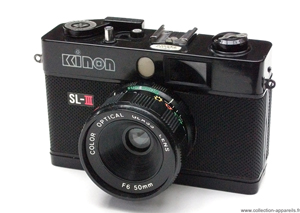 Like a Haking camera Like a Haking cameraOval window above the lens, serving no purpose |
Kinon SL-III |
 |
Color Optical Glass Lens F 6 50 mm |
|
 Opaque window in line with the lens (non-functional) Film advance lever |
Super II |  |
Optical Color Lens Auto Fix Focus 50 mm Lens 1:6 |
|
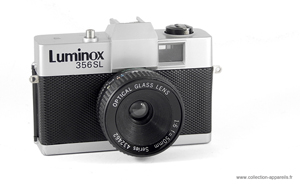 Off-center viewfinder Off-center viewfinderProminence of the bulge towards the front |
Luminox 356 SL |
Optical Glass Lens 1:6 f=50mm series 432462 |
432462 | |
| Premier PC-90 |
Optical Glass Lens series 198523 |
198523 | ||
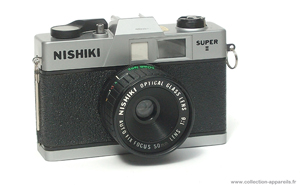 Off-center viewfinder Off-center viewfinderOpaque window in line with the lens (non-functional) Film advance lever |
Nishiki Super II |
Nishiki Optical Glass Lens Auto Fix Focus 50mm Lens 1:6 |
||
 Off-center viewfinder Off-center viewfinderOpaque window in line with the lens (non-functional) Frame counter on the top cover |
Optiflex NF-1 |
Optiflex Color Optical Glass Lens 1:6 f=50mm series 746277 |
746277 | |
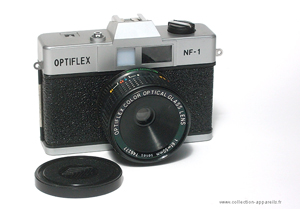 Off-center viewfinder Off-center viewfinderOpaque window aligned with the lens (non-functional) |
Optiflex NF-1 |
Optiflex Color Optical Glass Lens 1:6 f=50mm series 746277 |
746277 | |
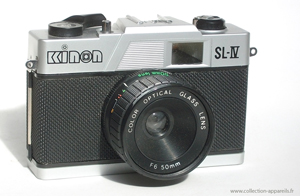 Film advance lever Film advance leverWide and low shoe base |
Kinon SL-IV |
Color Optical Glass Lens F 6 50 mm |
||
 Off-center viewfinder. Off-center viewfinder.Covered window under the bulge. The shutter release button is on a small platform. |
BW-7000 | Optical Color Lens Auto Fix Focus 50mm Lens 1:6 |
||
| UCC UC300 | ||||
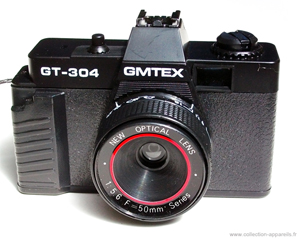 SLR-like form. Side viewfinder. Bulge for better grip. |
GMTEX GT-304 |  |
New Optical Lens 1:5.6 f 50 mm Series |
|
| Comax LT-002 |  |
Comax Optical Lens 1:6 f 50 mm Series |
||
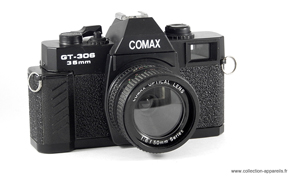 SLR-like shape. Side viewfinder. Bulge for better grip. Advance lever. |
Comax GT-306 | Comax Optical Lens 1:6 f 50 mm Series |
||
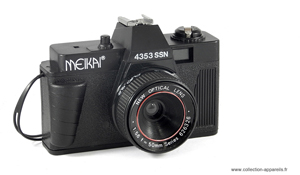 SLR-like shape. Side-mounted viewfinder. Bulge for improved grip. |
Meikai 4353 SSN | New Optical Lens 1:5,6 f=50 mm Series 626326 |
626326 | |
| ESC | ||||
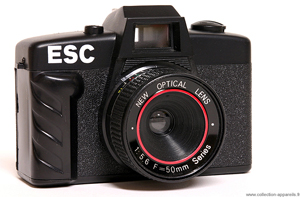 SLR-like shape. Viewfinder aligned with the lens. |
ESC | New Optical Lens 1:5,6 F = 50 mm Series |
||
| Roniflex X3000 | ||||
| GM Tex GT-304 | ||||
 Off-center viewfinder. Window obscured beneath the bulge. |
(Time) | Kinetic Optical Color Lens Auto Fix Focus 50mm Lens 1:6 |
||
| Nikanon RX-7 |
Nikanon Color Optical Glass Lens 1:6 f=50mm series 746277 |
746277 | ||
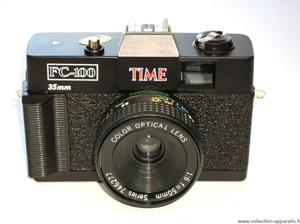 |
FC-100 (Time) |  |
Color Optical Lens 1:6 f=50mm series 746277 |
746277 |
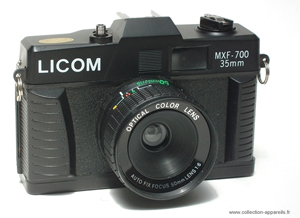 Finger rest at each end. Finger rest at each end.Off-center viewfinder. Window obscured beneath the bulge. |
Licom MXF-700 |
 |
Optical Glass Lens Auto Fix Focus 50mm Lens 1:6 |
|
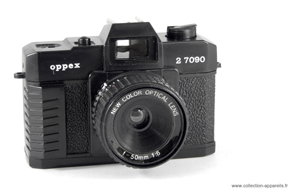 Reflex-like appearance. Viewfinder within the faux prism bulge. |
Oppex 2 7090 | New Color Optical Lens f=50mm 1:6 |
||
| Oppex 7090 | ||||
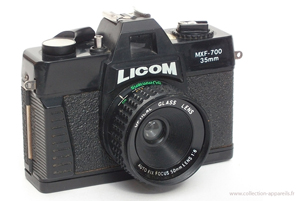 Reflex-like appearance. Reflex-like appearance.Viewfinder within the faux prism bulge. Advance lever. |
Licom MXF-700 |
Optical Glass Lens Auto Fix Focus 50mm Lens 1:6 |
||
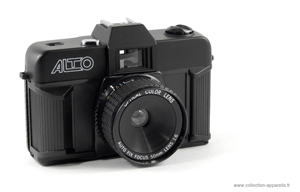 Reflex-like appearance. Reflex-like appearance.Viewfinder within the faux prism bulge. |
Alto | Optical Color Lens Auto Fix Focus 50mm Lens 1:6 |
||
| Deluxe-III | ||||
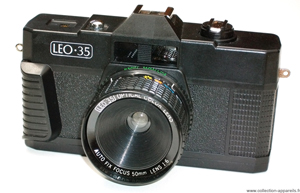 SLR-like shape. Two viewfinder windows aligned with the lens. |
Leo.35 | Leo. 35 Optical Color Lens Auto Fix Focus 50 mm Lens 1:6 |
||
 Reflex-like appearance. Reflex-like appearance.Finger rest at one end. Off-center viewfinder. Window obscured beneath the bulge. |
Eureka 2436 | New Color Optical Lens 1:6 f=50mm series 347859 |
347859 | |
| Weyburn F6 | ||||
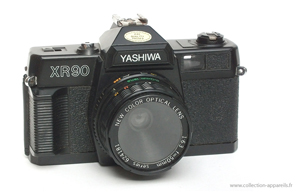 Reflex-like appearance. Reflex-like appearance.Off-center viewfinder. Finger rest on the right-hand side. |
Yashiwa XR90 |
New Color Optical Lens 1:6,3 f=50mm series 624181 |
624181 | |
__________
This was the camera for people who could not decide between a Nikon and a Canon; and could not afford either! We know that this camera was made and sold by FPC because it has an "FPC Quality Passed" sticker on it. It is a representative of one of FPC’s most successful designs, and appears under several other names. The TIME and Sports Illustrated magazine versions alone would have run to many thousands of units. (The TIME camera famously has a “kinetic optical color lens” (plastic) or a “kinetic optical glass lens”)
It is one of only two Nikanons found so far; the other one, the Nikanon YN 300 is a representative of another very numerous family, (The Yunon Optical Company sold the same camera with the same model number) “RX-7” was a suffix used on several FPC cameras, and probably refers to the legendary Mazda RX-7 launched in 1978.
The Nikanon RX-7 has provision for a cable release or mechanical timer, and a nice weight, partly provided by about 100 grams of scrap metal in the base. These cameras are often dismissed as “pseudo SLR’s”, but no-one would really mistake this for an SLR would they? They are novelty cameras not to be taken too seriously. The ‘prism’ is just a protective shield around the ‘hot shoe’.
This camera was purchased in the original box with papers offering a Nikanon 218M electronic flash for an additional $20 and a "user lifetime” replacement warranty for $25; about the price of a new camera ! The box is silver-grey with black lettering like many other FPC cameras not ordered by corporate clients. The company name on the box is "Bracha Export Corp." of 1127 Broadway New York. Bracha described itself as both an importer and an exporter. The manual is written in English, French, German Spanish and Japanese (?).
This basic design has been found under 20+ different names. Many of them have plastic lenses, by the omission of the word “glass”. There is a variant with the same body but with lever wind. (Kinusa KX-7)


Interesting links or bibliography :
 |
Add a link or element of bibliography, a picture taken with this camera, a picture of box or an ads about this camera
Your photos taken with the same camera:
Cameras from Ebay France (Formosa Plastics Corporation) (Uploaded each 3 hours)








